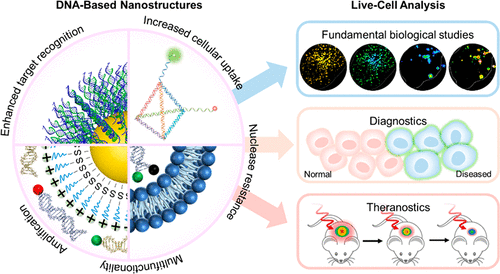当前位置:
X-MOL 学术
›
J. Am. Chem. Soc.
›
论文详情
Our official English website, www.x-mol.net, welcomes your feedback! (Note: you will need to create a separate account there.)
DNA-Based Nanostructures for Live-Cell Analysis
Journal of the American Chemical Society ( IF 15.0 ) Pub Date : 2020-06-23 , DOI: 10.1021/jacs.0c04978 Sasha B. Ebrahimi , Devleena Samanta , Chad A. Mirkin
Journal of the American Chemical Society ( IF 15.0 ) Pub Date : 2020-06-23 , DOI: 10.1021/jacs.0c04978 Sasha B. Ebrahimi , Devleena Samanta , Chad A. Mirkin

|
DNA-based probes constitute a versatile platform for making biological measurements due to their ability to recognize both nucleic acid and non-nucleic acid targets, ease of synthesis and chemical modification, amenability to be interfaced with signal amplification schemes, and inherent biocompatibility. Here, we provide a historical perspective of how a transition from linear DNA structures toward more structurally complex nanostructures has revolutionized live-cell analysis. Modulating the structure gives rise to probes that can enter cells without the aid of transfection reagents and can detect, track, and quantify analytes in live cells at the single-organelle, single-cell, tissue section, and whole organism levels. We delineate the advantages and disadvantages associated with different probe architectures and describe the advances enabled by these structures for elucidating fundamental biology as well as developing improved diagnostic and theranostic systems. We also discuss the outstanding challenges in the field and outline potential solutions.
中文翻译:

用于活细胞分析的基于 DNA 的纳米结构
基于 DNA 的探针构成了进行生物测量的通用平台,因为它们能够识别核酸和非核酸靶标,易于合成和化学修饰,易于与信号放大方案连接,以及固有的生物相容性。在这里,我们提供了一个历史视角,说明从线性 DNA 结构到结构更复杂的纳米结构的转变如何彻底改变了活细胞分析。调节结构产生的探针可以在没有转染试剂的帮助下进入细胞,并且可以在单细胞器、单细胞、组织切片和整个生物体水平检测、跟踪和量化活细胞中的分析物。我们描述了与不同探针架构相关的优缺点,并描述了这些结构在阐明基础生物学以及开发改进的诊断和治疗诊断系统方面取得的进步。我们还讨论了该领域的突出挑战并概述了潜在的解决方案。
更新日期:2020-06-23
中文翻译:

用于活细胞分析的基于 DNA 的纳米结构
基于 DNA 的探针构成了进行生物测量的通用平台,因为它们能够识别核酸和非核酸靶标,易于合成和化学修饰,易于与信号放大方案连接,以及固有的生物相容性。在这里,我们提供了一个历史视角,说明从线性 DNA 结构到结构更复杂的纳米结构的转变如何彻底改变了活细胞分析。调节结构产生的探针可以在没有转染试剂的帮助下进入细胞,并且可以在单细胞器、单细胞、组织切片和整个生物体水平检测、跟踪和量化活细胞中的分析物。我们描述了与不同探针架构相关的优缺点,并描述了这些结构在阐明基础生物学以及开发改进的诊断和治疗诊断系统方面取得的进步。我们还讨论了该领域的突出挑战并概述了潜在的解决方案。


























 京公网安备 11010802027423号
京公网安备 11010802027423号